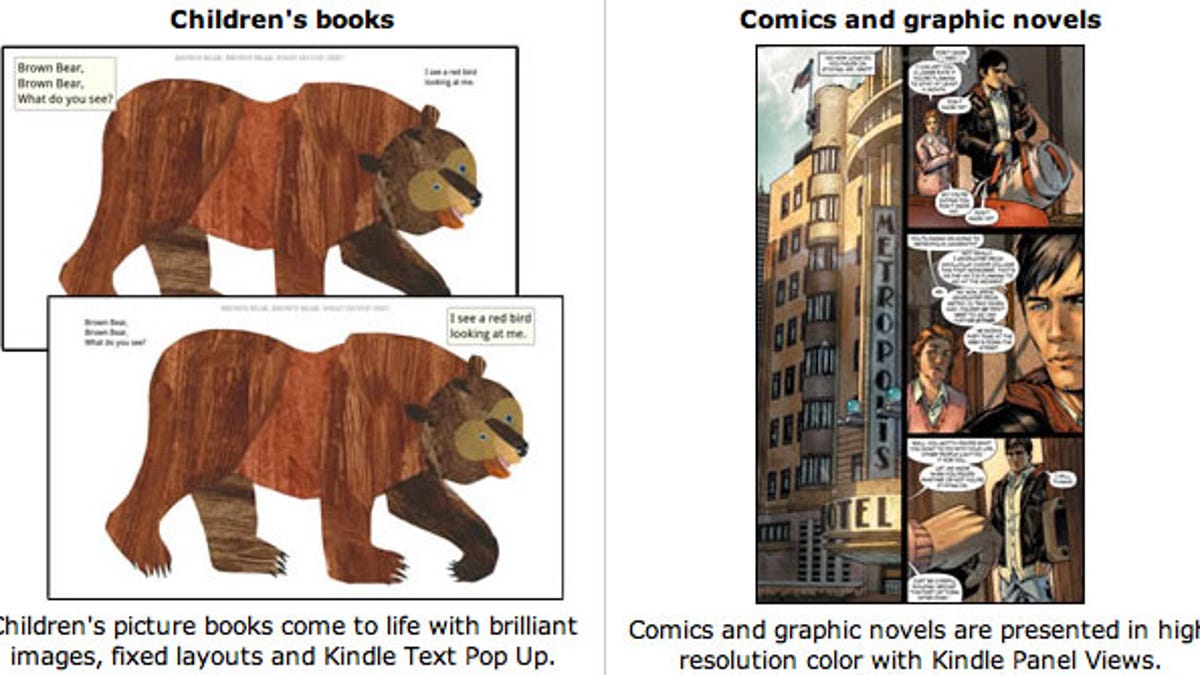 Why You Can Trust CNET
Why You Can Trust CNET Web-based Kindle format good for comics, kids' books
Pining for an e-cookbook with color photos? A new format dramatically expands what types of books Amazon's e-reader can display and adds Web publishing support.

Amazon has retooled and renamed the format for electronic books, embracing Web technologies and adding better abilities for graphics and complex layouts.
The previous format, Mobi 7, will be replaced by Kindle Format 8, aka KF8, according to an Amazon announcement yesterday.
"As showcased on Kindle Fire, KF8 enables publishers to create great-looking books in categories that require rich formatting and design such as children's picture books, comics & graphic novels, technical and engineering books, and cookbooks," Amazon said in its announcement. "Kindle Format 8 replaces the Mobi format and adds over 150 new formatting capabilities, including fixed layouts, nested tables, callouts, sidebars and Scalable Vector Graphics, opening up more opportunities to create Kindle books that readers will love."
The Kindle Fire is Amazon's entry into the tablet market, building on the company's experience with its popular Kindle e-readers. It goes on sale November 15.
A move of this sort was inevitable as e-book publishing broadened beyond the initial text-centric focus. For example, Amazon is licensing rights to comic books, a natural fit for reading on tablets.
That KF8 supports Web technologies isn't a great surprise, either, given the cross-platform nature of the technology. KF8 support embraces HTML (Hypertext Markup Language, which encodes Web page content) and CSS (Cascading Style Sheets, which handles formatting of increasing complexity).
One particularly welcome option to some publishers doubtless will be the inclusion of CSS's @font-face interface, which lets people specify a downloadable font. That stands to dramatically expand the typographical options for publishers.
The choice of Web viewing technology also could make Kindle e-books more easily digested by Amazon's Kindle Web apps, though digital rights management (DRM) restrictions complicate the matter beyond simply clicking a URL with the KF8 document.
Note also that with the Kindle Fire, Amazon will have its own browser, called Silk. It's based on the open-source WebKit project that's also at the heart of Apple's Safari and Google's Chrome. By using Web technologies such as HTML5 and CSS3, Amazon benefits from others' work to produce a document rendering engine that's steadily increasing in features and performance.
CSS is increasingly powerful, with 3D animation effects and layout abilities to set text to flow around graphics. It could help books become more dynamic.
But even more liveliness is possible with browsers these days, because JavaScript makes Web pages more programmable. There's no indication at this stage that Amazon plans to unlock this particular potential ability for e-books, but it's certainly possible. For a look at the future of e-books that diverge radically from what's possible with paper publishing, check The Fantastic Flying Books of Mr. Morris Lessmore, which technically is an iPad app.
It's a children's book with a playable piano, characters that change outfits when you tap on them, and many other animated, interactive features. Expect more of this, not less.
Amazon hasn't yet released development tools to let publishers produce KF8-formatted content, but it will. That will include KindleGen 2 for creating Kindle content from files in HTML, XHTML, and the Epub format, and Kindle Previewer 2 to let publishers see what their e-books will look like.
The change also means new decisions for those reading e-books. Tablets, such as the widely used iPad and Amazon's upcoming Android-based Kindle Fire, can show color that's well suited for children's books, comics, travel guides, cookbooks, and many other areas. But the present Kindle reader line uses e-ink, a display technology that offers superior battery life and letters that many find easier to read. E-ink doesn't offer color.

